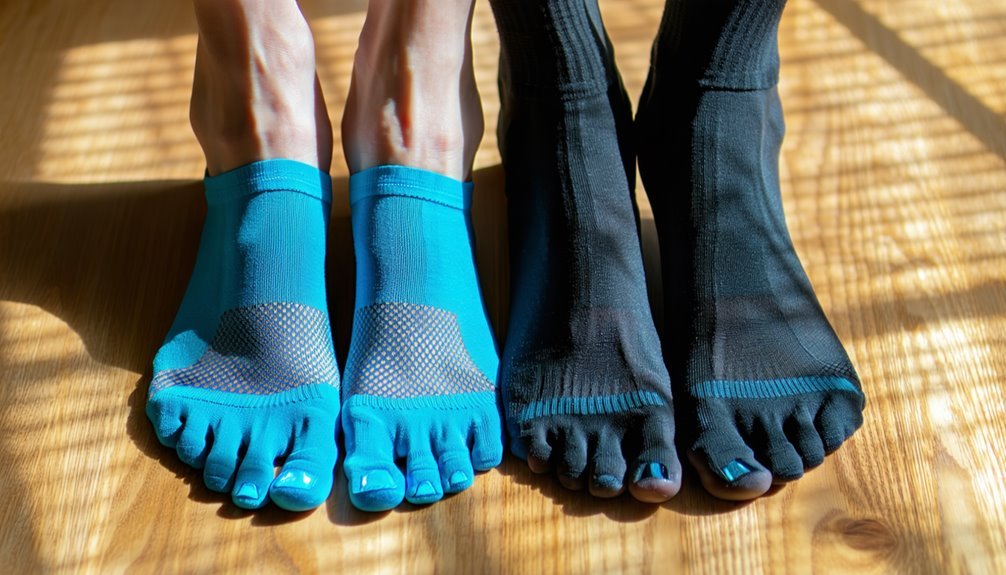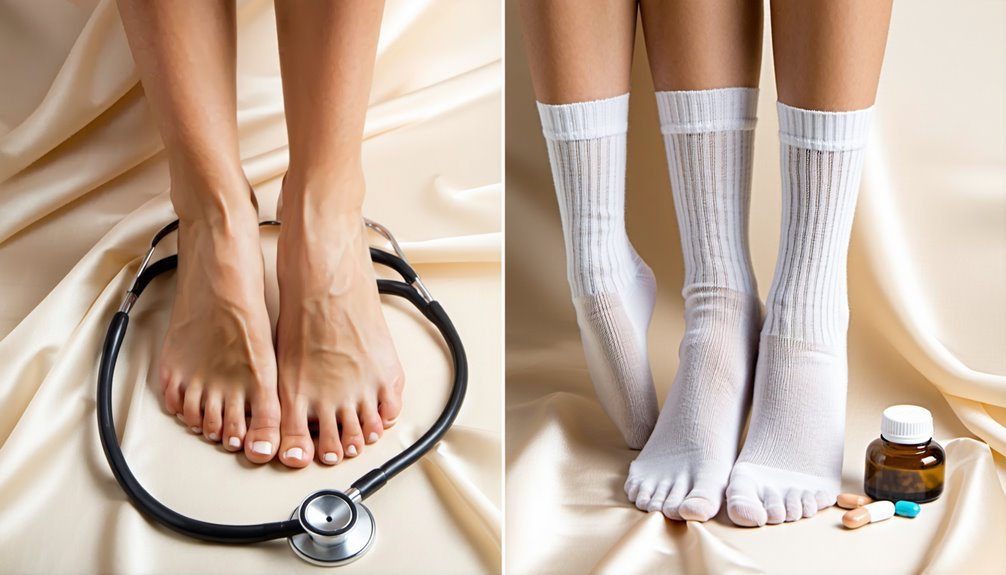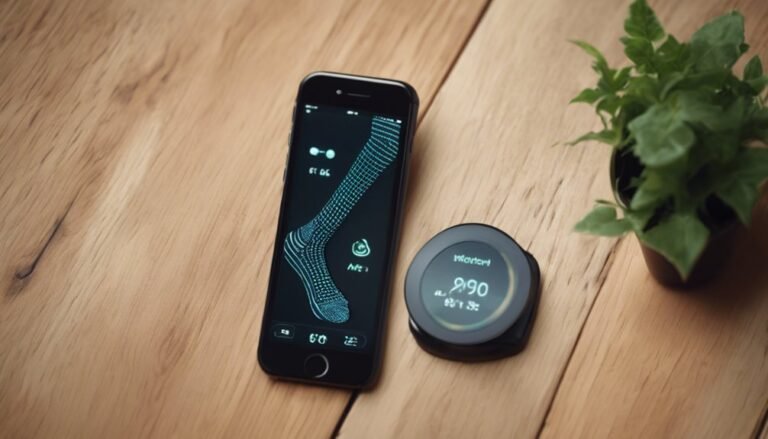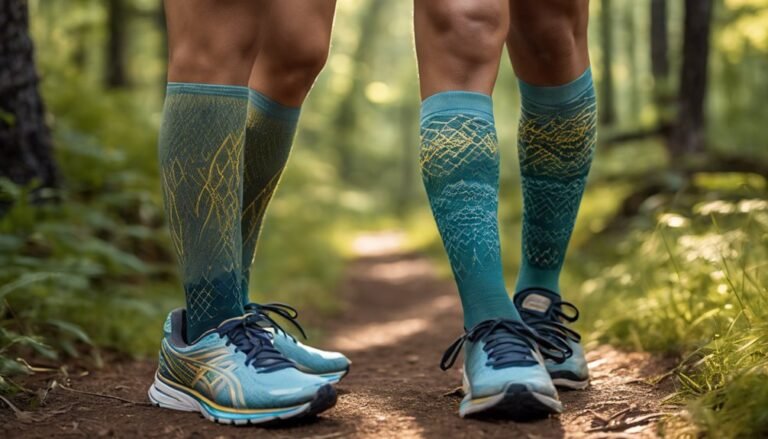Open Toe Vs Closed Toe Compression Socks
Choosing between open toe and closed toe compression socks depends mainly on your foot health needs. Open toe designs offer enhanced toe ventilation, flexibility, and reduced moisture buildup, ideal for sensitive or swollen toes. Closed toe socks provide uniform compression, improved circulation, and greater support, benefiting overall foot stability. Evaluate which design best aligns with your medical conditions and lifestyle for best foot health and therapeutic outcomes. Understanding the nuances can further enhance your decision-making.
Understanding Compression Sock Basics

Compression socks serve as a therapeutic tool designed to apply graduated pressure to the legs, enhancing venous return and reducing edema. You're likely aware that these socks come in various types, each tailored for specific compression sock uses. For instance, medical-grade compression socks are often prescribed for chronic venous insufficiency, while athletic versions boost performance and recovery. The pressure levels vary, ranging from mild, useful for daily wear and travel, to extra-firm, intended for severe medical conditions. It's important to select the appropriate type based on your needs. Properly fitted compression socks can greatly promote foot health by minimizing swelling and enhancing circulation. Remember, using the right compression level guarantees you experience therapeutic benefits while maintaining safety and comfort.
Key Differences Between Open Toe and Closed Toe Designs
When selecting the right compression sock, the design choice between open toe and closed toe can greatly impact your comfort and therapeutic outcomes. Open toe benefits include increased ventilation and reduced pressure on the digits, ideal for individuals with sensitive or swollen toes. This design allows for better toe movement, which can be vital for maintaining circulation and preventing moisture buildup, particularly in warmer climates.
On the other hand, closed toe advantages include thorough coverage, providing uniform compression from foot to knee. This design is beneficial for those seeking full support for edema management or venous return improvement. It also offers added protection and warmth, which can be fundamental in cooler environments. Ultimately, your choice should be guided by specific medical needs and personal comfort preferences.
Benefits of Open Toe Compression Socks
Although often overlooked, open toe compression socks offer significant benefits for individuals with specific foot health needs. With open toe advantages, these socks enhance foot ventilation, reducing moisture buildup and lowering the risk of fungal infections. The design allows for greater flexibility and comfort, accommodating various foot shapes and sizes without compromising compression efficacy. This is particularly beneficial for those with sensitive toes or toenail issues. Furthermore, they enable easy inspection of the toes, ensuring prompt identification of potential foot health concerns.
Here's a comparison to help you understand:
| Feature | Open Toe Compression Socks |
|---|---|
| Foot Ventilation | Enhanced |
| Moisture Control | Improved |
| Flexibility | Increased |
| Toe Sensitivity | Less irritation |
| Visual Inspection | Facilitated |
Ultimately, these socks are an excellent choice for ensuring foot safety and health.
Benefits of Closed Toe Compression Socks
For individuals seeking thorough foot coverage and uniform compression, closed toe compression socks provide a distinct advantage. These socks are expertly designed to enhance venous return, promoting improved circulation throughout the entire foot. When you wear them, you experience extensive foot support, reducing the risk of potential injuries and providing comfort during prolonged periods of standing or walking. Such socks are especially beneficial if you're concerned about maintaining ideal foot health and preventing common foot ailments.
- Enhanced support: Offers stability and alignment for the entire foot.
- Improved circulation: Guarantees blood flow is maximized from toes to calves.
- Injury prevention: Helps in reducing the likelihood of strains and sprains.
- Thermal regulation: Keeps feet warm, reducing risk of cold-related issues.
- Hygienic coverage: Protects feet from dirt and contaminants.
Considerations for Athletes

While closed toe compression socks offer extensive benefits, athletes have specific needs to take into account when choosing between open and closed toe options. Performance enhancement and injury prevention are vital. Open toe variants allow for better toe splay, essential for balance and agility. Closed toe socks, however, provide more thorough foot coverage, enhancing venous return and reducing edema.
| Feature | Open Toe Benefits | Closed Toe Benefits |
|---|---|---|
| Toe Mobility | Enhanced toe splay | Limited toe movement |
| Circulation | Moderate venous return | Enhanced venous return |
| Sweat Management | Improved toe ventilation | Reduced moisture escape |
| Protective Coverage | Partial coverage | Full coverage for injury prevention |
Choosing the right type depends on your sport-specific requirements and foot health needs, ensuring both safety and ideal performance.
Travel and Compression Sock Choices
When choosing compression socks for travel, especially during long flights, consider both the style and your specific comfort needs. Evidence suggests that compression socks can mitigate the risk of deep vein thrombosis by improving venous return. Open toe options may enhance comfort by allowing more flexibility and ventilation, while closed toe variants offer extensive foot support.
Sock Style Preferences
Why might you choose one style of compression sock over the other when traveling? Your choice often hinges on personal preferences and specific foot health considerations. Open toe compression socks might appeal to those desiring more breathability and toe freedom. Meanwhile, closed toe options offer extensive support, potentially reducing the risk of swelling during prolonged periods of inactivity. Consider the following when selecting your travel socks:
- Sock color: Darker hues might hide stains better during long trips.
- Fabric patterns: Choose patterns that match your wardrobe while providing therapeutic support.
- Pressure gradient: Confirm the compression level meets your medical needs.
- Material: Opt for moisture-wicking fabrics to maintain foot hygiene.
- Ease of use: Select socks that are easy to put on and take off quickly.
These considerations prioritize your safety and comfort.
Comfort During Flights
As you commence air travel, optimizing comfort during flights is essential, especially regarding foot health. Prolonged flight duration can predispose you to conditions like deep vein thrombosis (DVT). Wearing compression socks can mitigate this risk by enhancing venous return, thereby promoting circulatory efficiency. When choosing between open toe and closed toe compression socks, consider passenger comfort and individual anatomical needs.
Open toe variants may offer more breathability and flexibility, beneficial during long flights when feet might swell. Conversely, closed toe socks provide uniform compression, potentially increasing support for the entire foot. Evidence suggests that both types can effectively reduce edema and discomfort. Ultimately, selecting the appropriate style hinges on your specific comfort preferences and flight duration requirements. Prioritize your foot health for safer, more pleasant travels.
Addressing Medical Needs With Compression Socks

Although compression socks come in various styles, their primary function remains to support medical needs effectively. When dealing with medical conditions that impact blood flow, compression socks can greatly enhance circulation improvement. Wearing these socks can be essential for individuals with conditions like chronic venous insufficiency or lymphedema, as they help prevent complications by promoting blood flow and reducing swelling.
- Chronic venous insufficiency management
- Edema reduction and control
- Deep vein thrombosis prevention
- Post-surgical recovery support
- Diabetic foot care
Style and Aesthetic Preferences
When it comes to choosing between open toe and closed toe compression socks, how do you decide which suits your needs? Aesthetic preferences play a significant role. Open toe designs align with current fashion trends, offering a versatile look that pairs well with sandals or peep-toe shoes. This feature allows you to maintain foot health while embracing style. Closed toe options, on the other hand, provide a more traditional appearance, often preferred for their uniform look. Color choices also impact your decision. Compression socks are available in various shades, allowing you to match them with your wardrobe while ensuring safety and comfort. Ultimately, selecting the right style involves balancing medical efficacy with personal style preferences, ensuring both therapeutic benefits and aesthetic appeal.
Tips for Choosing the Right Compression Socks for You
When selecting compression socks, it's essential to assess the appropriate compression level, as this directly impacts circulatory efficacy and symptom management. Evaluate sock material for its breathability and moisture-wicking properties to guarantee ideal skin health. Most importantly, prioritize your comfort by considering fit and any unique foot conditions, as these factors greatly influence adherence to wearing them consistently.
Consider Compression Level
Understanding the appropriate compression level is crucial when selecting the right compression socks for your needs, as this determines their effectiveness in promoting blood circulation and alleviating symptoms like swelling and discomfort. Compression levels are typically measured in millimeters of mercury (mmHg) and guided by medical guidelines. Selecting an improper level might compromise safety and efficacy.
Consider these points:
- 15-20 mmHg: Mild compression for daily wear, travel, and minor swelling.
- 20-30 mmHg: Moderate compression for managing varicose veins and mild edema.
- 30-40 mmHg: Firm compression for severe varicosities or post-surgical use.
- Consult a healthcare professional for personalized advice.
- Monitor skin and comfort regularly to guarantee appropriate fit and pressure.
Prioritize your foot health by adhering to recommended compression levels.
Evaluate Sock Material
While the compression level guarantees the socks' effectiveness in promoting circulation, the material composition greatly influences comfort and performance. Selecting the right material is vital for sock durability and material breathability, which are essential for maintaining foot health. Opt for high-quality fabrics like nylon and spandex, known for their elasticity and resilience. These materials not only enhance durability but also guarantee a snug fit, reducing the risk of slippage and skin irritation. Breathable materials, such as those blended with cotton or moisture-wicking synthetics, help regulate temperature and prevent excessive sweating, thereby minimizing the risk of fungal infections. By prioritizing these material properties, you can guarantee your compression socks provide peak support and safeguard your feet's health effectively.
Prioritize Comfort Needs
Since guaranteeing ideal foot health is paramount, it's essential to focus on comfort when choosing compression socks. Prioritizing comfort features not only enhances the wearability of the socks but also prevents complications like pressure ulcers or impaired circulation. Leveraging user feedback can guide your selection process. Consider these factors:
- Cushioning: Look for socks with adequate padding to reduce friction.
- Breathability: Opt for materials that wick moisture and allow airflow.
- Seamless design: A seamless construction prevents irritation and blister formation.
- Graduated compression: Confirm the socks offer a gradient of compression, higher at the ankle and decreasing upwards.
- Size accuracy: Verify the sizing guidelines align with your foot dimensions to avoid undue pressure.
Your choice should align with medical recommendations for ideal safety and efficacy.
Frequently Asked Questions
Can Compression Socks Be Worn Overnight?
You shouldn't wear compression socks overnight unless prescribed. Overnight benefits depend on compression levels and individual foot health. Improper use may impair circulation. Consult a healthcare professional to verify safety and ideal results tailored to your needs.
How Do I Wash Compression Socks Properly?
Carefully consider compression sock care. Cleanse conscientiously with cool water, utilizing gentle washing techniques. Employ a mild detergent, avoiding harsh chemicals. Hand wash when possible, ensuring elasticity remains intact. Prioritize air drying to preserve fabric integrity and promote foot health.
What Materials Are Best for Compression Socks?
For ideal foot health, choose compression sock materials like nylon and spandex, which offer elasticity and gentle pressure. Moisture-wicking fabrics, such as polyester blends, prevent dampness, reducing bacterial growth and ensuring safety. Prioritize comfort and breathability in your selection.
Do Compression Socks Have Expiration Dates?
Ever wondered if compression socks expire? They do. Look for expiration signs like reduced elasticity or fraying. Compression lifespan varies, but generally lasts 3-6 months with frequent use, ensuring ideal foot health and safety. Stay vigilant.
Can Compression Socks Cause Any Skin Irritations?
You might experience skin sensitivity from compression socks, especially if worn improperly. To prevent irritation, guarantee proper fit and material choice. Evidence suggests that proper care and rotation can reduce skin issues, enhancing foot health safety.







